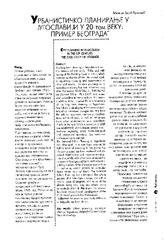Приказ основних података о документу
City planning in Yugoslavia in the 20th century: The case study of Belgrade
Урбанистичко планирање у Југославији у 20-том веку - пример Београда
| dc.creator | Bajić-Brković, Milica V. | |
| dc.date.accessioned | 2020-11-27T18:15:46Z | |
| dc.date.available | 2020-11-27T18:15:46Z | |
| dc.date.issued | 2002 | |
| dc.identifier.issn | 0354-6055 | |
| dc.identifier.issn | 2217-8074 | |
| dc.identifier.uri | https://raf.arh.bg.ac.rs/handle/123456789/1077 | |
| dc.description.abstract | The long term planning in Yugoslavia is usually associated with early 1930s and with issuing of the Building Code in 1931, which represented the first official document legally regulating planning and construction of cities and towns. The term planning in its nowadays meaning has first appeared only after the Second World War. In 1949 the Act on General Urban Plan (GUP) was issued and according to many authors that was a crucial point that marked the very beginning of the long term planning in Yugoslavia. Since then its development has been characterized by numerous changes resulting from the political, economic and social modifications and tendencies, as well as influences from other environments and disciplines. Finally, in the mid-1960s a paradigm of GUP was established, which despite several modifications regarding some methodological and procedural questions, has remained unchanged up to our day. The General Urban Planning in Yugoslavia has developed in a paradigm manner, in Kuhn’s sense of meaning. In this paper this fifty year process has been explored and discussed. Kuhn’s views and theory on the structure of scientific revolution have provided the conceptual background for it, and helped in guiding analysis of the phenomena as well as in explaining certain phases or particular facets within each of them. The General Urban Planning has undergone the whole process of a paradigm change but with a specific pace of progress, with some of the phases being very long and others being exceedingly short. In this paper this process has been reviewed and development of the GUP model presented and discussed. To illustrate the point the case study of the city of Belgrade has been drawn. | en |
| dc.language.iso | sr | sr |
| dc.publisher | Institute of Architecture and Urban and Spatial Planning of Serbia | sr |
| dc.rights | openAccess | sr |
| dc.rights.uri | https://creativecommons.org/licenses/by-sa/4.0/ | |
| dc.source | Arhitektura i Urbanizam | sr |
| dc.subject | Urban planning | sr |
| dc.subject | Paradigm change | sr |
| dc.subject | Yugoslavia | sr |
| dc.subject | Begrade General Urban Plan | sr |
| dc.subject | Methodology | sr |
| dc.title | City planning in Yugoslavia in the 20th century: The case study of Belgrade | en |
| dc.title | Урбанистичко планирање у Југославији у 20-том веку - пример Београда | sr |
| dc.type | article | sr |
| dc.rights.license | BY-SA | sr |
| dcterms.abstract | Бајић-Брковић, Милица В.; Urbanističko planiranje u Jugoslaviji u 20-tom veku - primer Beograda; | |
| dcterms.abstract | Бајић-Брковић, Милица В.; Urbanističko planiranje u Jugoslaviji u 20-tom veku - primer Beograda; | |
| dc.citation.issue | 9 | |
| dc.citation.spage | 19 | |
| dc.citation.epage | 31 | |
| dc.identifier.fulltext | https://raf.arh.bg.ac.rs/bitstream/id/3729/BajicBrkovicMilica.pdf | |
| dc.identifier.rcub | https://hdl.handle.net/21.15107/rcub_raf_1077 | |
| dc.type.version | publishedVersion | sr |

